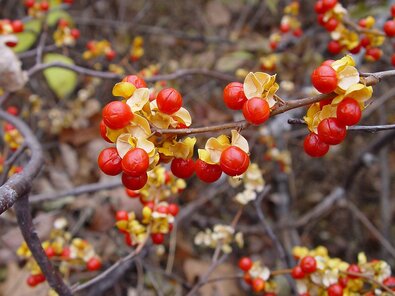Criteria 3 - Remove Invasive Species
|
Invasive Plants
Invasive plants and insects pose serious risks to the biodiversity and functionality of our ecosystems as well as for producing lands including forests and agriculture. Many landowners have invasive plants on their land or nearby and want to understand how to control them or prevent infestation. What are invasive plants? In Maine a plant is considered invasive if it:
Invasive species are the second-greatest threat to global biodiversity after loss of habitat. Invading plants out compete native species by hogging sunlight, water, nutrients, and space. They change animal habitat by eliminating native foods, altering cover, and destroying nesting opportunities. Some invaders are so aggressive they leave no room for our natives. Many invasive plants are still attractive to the home gardener, and many nurseries and garden centers still sell them, even though its illegal. There are many native alternatives to popular invasives, so if you have to remove an invasive that you liked--know that there are other, native plants that will do the job better for the ecosystem of your yard! Invasive Insect Pests Besides invasive plants, Maine also has invasive animals including insects. See the Maine Forest Service website and our Invasives resource page for more information on these pests. You should monitor your property for the presence of these pests and alert us if you think you’ve found these insects on your land or elsewhere in Androscoggin or Sagadahoc Counties. Recommendations: First take an inventory of what you have on your property, and decide how you would like to work on removal. Chemical, Mechanical or Biological. Invasive species can take a long time to remove, so start small and be diligent! Species that are well established may take years to remove from your property. Also look into re-planting natives as soon as possible, which will lower the likelihood of the invasives coming back. |
Resources for Criteria 3
Invasive Pests + Pathogens
The Maine Forest Service provides information and assistance with forest insect pests and other pathogens.
Invasive Plants
Invasive Plants - The Maine Department of Agriculture, Conservation and Forestry's Horticulture Department has the most up to date information on invasive species across the state including the Do Not Sell List, and recommendations and resources for replacing invasive plants.
Invasive Plants in Maine (Maine Natural Areas Program) - Invasive and potentially invasive plants list for Maine, click the plant name to access fact sheets for each.
Invasive.org - A great starting place, with numerous images of each plant, and concise, thorough fact sheets on different species.
The link Species is where you can find info pages on each plant and pictures as well as additional links.
Invasipedia Excellent literature summary articles on most invasive plants, more in-depth than fact sheets.
USDA Forest Service FEIS Database This site provides an in-depth profile of each invasive species, with citations to assist further research.
Imap Invasives - Maine Natural Areas Program IMap Invasives is an invasives tracking program now available in Maine, with many tools and data resources to help communities and land owners and managers plan for invasives control.
Vermont Invasives Resources - Vermont has a well-developed invasives program which includes several excellent guides.
Aquatic Invasives
Maine Volunteer Lake Monitoring Program - Many opportunities to volunteer, and they offer some excellent training workshops and materials on aquatic invasives.
The Maine Forest Service provides information and assistance with forest insect pests and other pathogens.
Invasive Plants
Invasive Plants - The Maine Department of Agriculture, Conservation and Forestry's Horticulture Department has the most up to date information on invasive species across the state including the Do Not Sell List, and recommendations and resources for replacing invasive plants.
Invasive Plants in Maine (Maine Natural Areas Program) - Invasive and potentially invasive plants list for Maine, click the plant name to access fact sheets for each.
Invasive.org - A great starting place, with numerous images of each plant, and concise, thorough fact sheets on different species.
The link Species is where you can find info pages on each plant and pictures as well as additional links.
Invasipedia Excellent literature summary articles on most invasive plants, more in-depth than fact sheets.
USDA Forest Service FEIS Database This site provides an in-depth profile of each invasive species, with citations to assist further research.
Imap Invasives - Maine Natural Areas Program IMap Invasives is an invasives tracking program now available in Maine, with many tools and data resources to help communities and land owners and managers plan for invasives control.
Vermont Invasives Resources - Vermont has a well-developed invasives program which includes several excellent guides.
Aquatic Invasives
Maine Volunteer Lake Monitoring Program - Many opportunities to volunteer, and they offer some excellent training workshops and materials on aquatic invasives.
Find Us At:254 Goddard Rd
Lewiston, Me 04240 |
Contact Us:Project Director, Emma Lorusso
(207) 241-5374 [email protected] Technical Director, Sarah Torresen (207) 241-5377 [email protected] STAY UPDATED BY ADDING US ON : |

